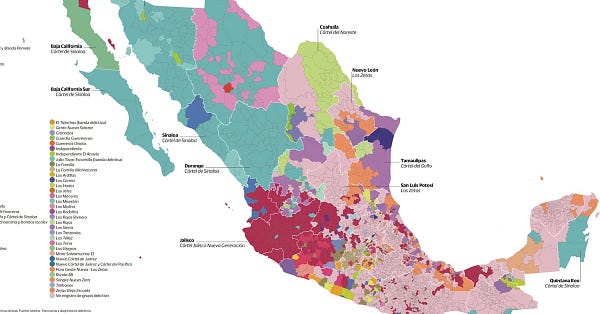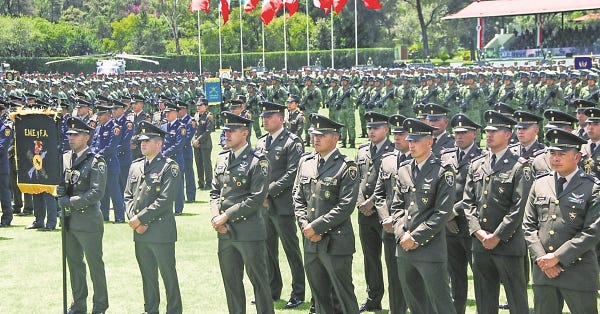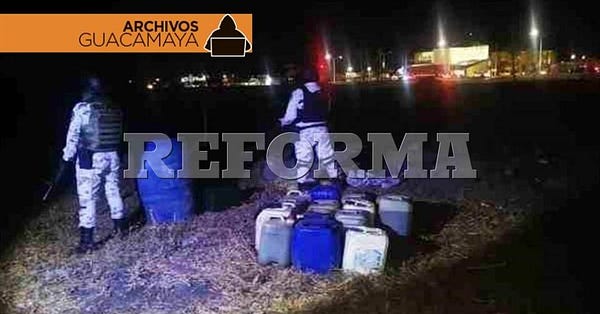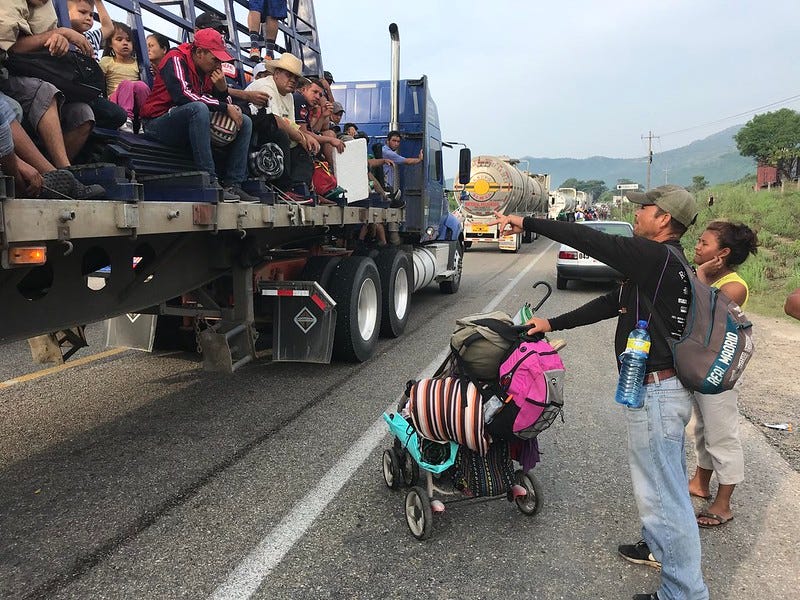#SedenaLeaks Part 2: The leaks keep coming
AMLO bets on public apathy as the scandal unfolds, while the military stays silent
Mexico’s military remains silent more than a month after the massive leak of documents from the Defence Secretariat, which was hacked by activist group Guacamaya. Defence Secretary Gen. Luis Cresencio Sandoval refused to appear at before the national defence committee in the lower house of Congress to explain the hack, then sat silently in the Senate as opposition lawmakers unloaded on him. Sen. Germán Martínez, a former PAN party leader in the late 2000s who entered the Senate with president AMLO’s MORENA party, thundered at the general:
“Those of us who have made accusations against military activities in the exercise of our legislative work do not deserve your reproach. I will not accept it. I am not your soldier, nor should we think the same way. I respect the uniform you wear, but that does not make you a better Mexican.”
President Andrés Manuel López Obrador, meanwhile, continued peddling the supposition that the leaks revealed nothing of interest and the public could care less, while also pursuing a strategy of betting on public apathy as the scandal unfolds.
Sure it’s costing them enormously. Imagine how many strategists, advisors and experts – and it turned out rotten for them. They would like that we continue speaking of this, but no. Better that they apply themselves and look for some other subject because this hasn’t worked.”
At his morning presser – an exercise in transparency, according to the president – AMLO refused to allow Sandoval to speak, saying it would would “stain” the proceedings and claiming the demands made of the minister were “politicking.”
He later presented a poll from the consultancy Enkoll, claiming only 29% of Mexicans were aware of the leaks, while 72% supported the army and/or navy administering Mexico’s customs service. Some 73% said soldiers and sailors should continue performing public security tasks until 2028 and 62% backed their work in building AMLO’s landmark infrastructure projects like the Mayan Train and Felipe Ángeles International Airport near Mexico City. AMLO boasted:
“It’s a lesson because what often happens is what we see on social media is what they see in all of the country, but no.”
The leaks, however, have kept on coming, spilling the secrets of Mexico’s most hermetic institution – the Defence Ministry (SEDENA) – and confirming suspicions of politicians, public officials and security forces colluding with drug cartels. The leaks also lent credence to the idea that Mexico’s military has actively pursued power and an increased role as Mexico’s political picture – while remaining stubbornly resistant to civilian oversight.
New organized crime map


A military intelligence analysis published by the newspaper El Universal found one or more criminal groups have a presence en 72% of Mexican territory. The reports identified more than 80 organized criminal groups and 16 criminal gangs, according to El Universal. Criminal groups operated in 1,058 of the country’s 2,440 municipalities, extending the length and breadth of the country.
In northern border states and along the Pacific – among other areas – cartels disputed control of entire regions. But in other parts of the country, usually in central and southern regions, “More than the presence of drug trafficking, it would seem that criminal groups dedicated to fuel theft and/or migrant smuggling are becoming stronger such as [the states of] Puebla, Hidalgo, Tlaxcala and Chiapas,” El Universal reported the intelligence report stating.
The reports, drafted in 2020 and 2022, put an emphasis on the territorial expansion of the Jalisco New Generation Cartel (CJNG), which has pushed into states far from its home base in western Jalisco state – such as Quintana Roo, where violence over drug dealing has erupted in tourist hotspots such as Cancún, Playa del Carmen and Tulum. (CJNG has disputed territory in Michaocán, which neighbours Jalisco, leaving communities there incommunicado, and, according to previous leaked emails, fought for control in eastern Veracruz state and had two men allegedly affiliated with it appointed to senior public security positions in Tabasco state.)
Despite the CJNG expansion, according to El Universal, the military intelligence report posited the Sinaloa Cartel controlled twice the territory as the CJNG.
Military brands Jesuit-run human rights organization ‘pressure group’

The Society of Jesus reacted bitterly to military intelligence reports branding its Mexican human rights centre a “pressure group,” while noting security service have long known the criminal accusations against a man accused of murdering two elderly Jesuits, but failed to stop him.
The Miguel Agustín Pro Juárez Human Rights Centre has regularly waded into some of Mexico’s thorniest conflicts. It legally represents families of the 43 teacher trainees disappeared in a 2014 attack perpetrated by cops acting in cahoots with criminals – who have long questioned the army’s role on the night of the crime.
The Jesuit province in Mexico also noted the military, according to leaked emails, was monitoring statements made by religious leaders in the area of the slayings. The Jesuits said in a statement:
“We reject that, in military documents, (the centre) is classified as a ‘pressure group’. We regret that public statements from the centre’s staff are subject to intensive monitoring, along with statements by the victims they accompany.
“According to the information published in the media, it would appear the Mexican State identified, in advance, the criminal activities in the Sierra Tarahumara of the person who would ultimately perpetrate the murders of our brothers [Fathers] Joaquín Mora and Javier Campos. … If (the State) had acted accordingly, the tragedy probably would have been avoided.
Mexican officials have offered a five million peso reward ($250,000) for the information leading to the arrest of local crime boss José Noriel Portillo Gil – known as “El Chueco,” the crooked one – who is accused of killing the priests after chasing a tour guide (also murdered) into their parish in the municipality of Urique, in the Copper Canyon of Chihuahua state. “El Chueco” remains on the lam.
El Chueco reputedly controls the crime territory around Urique for ‘Los Salazar,’ a group linked with the Sinaloa Cartel. His reach was so fearsome that federal officials allege he took a cut of 10% on copper mined in the region, while also controlling activities such as illegal logging, extortion and kidnapping.
He also appeared in the leaked SEDENA emails. Spanish newspaper El País published excerpts from a 2020 military intelligence report, which stated:
“Criminal groups have infiltrated public security organizations, which, being surpassed in manpower and/or weaponry, along with being threatened, opt not to carry out actions against them.”
El Chapo Isidro captured and released four times


A cartel boss nicknamed “El Chapo Isidro” – not to be confused with imprisoned Sinaloa Cartel kingpin Joaquín “El Chapo” Guzmán – was captured on four occasions, but released every time, according to leaked army emails. Fausto Isidro Meza Flores was detained four times between 2011 and 2015, according to the emails. Reasons for his release were not stated, though authorities at the federal and state level let him loose, according to Sinaloa newspaper Noroeste.
“El Chapo Isidro” is believed to be a leader of the Beltran Leyva Cartel, which warred with its former allies in the Sinaloa Cartel in the late 2000s and early 2010s. Noroeste reported the emails describing “El Chapo Isidro” as an ally of Rafael Caro-Quintero – nabbed by navy marines in July. The U.S. Department of the Treasury added him to the Foreign Narcotics Kingpin Designation Act in 2013.
Does AMLO do anything other than talk?
AMLO has gained a reputation as a workaholic, who rises early, travels the country incessantly and seldom takes a holiday – other than visiting his ranch in Chiapas. He convenes a meeting of his security cabinet weekday mornings in the National Palace, then talks for two hours – sometimes three hours – in a press conference known as the mañanera. But what happens afterward remains a mystery.
According to leaked army emails, AMLO usually retires after his morning press conference – spare weekends, when there is no presser and he’s touring the country, usually inspecting projects, inspecting rallies or tweeting stops at his favourite regional restaurants.
Journalist Sandra Romandía, writing for the commentary website OPINIÓN 51, reviewed the president’s schedule for 31 days between April 29, 2019, and May 29, 2019, and found the president had no other activities scheduled for those days. She wrote:
“Unless he goes on tour and participates in ‘supervising’ [projects] or a visit to some state, his agenda remains empty, blank with nothing else scheduled except receive the physical therapy that the military medical corps provide him.”
The importance of the mañanera – his press conference – for his administration is hard to overstate. Analysts compare it to former president Trump’s Twitter account (when he had one) in that it sets the news cycle, chastises and calls out critics and trolls opponents. AMLO also uses it to gaslight – saying often: I have other information, when presented with bad news – or badmouth the media. (See the section on the Ayotzinapa investigation below.)
National Guard has links to ‘huachicoleros’ (fuel thieves)
A military intelligence report from the leaked SEDENA emails alleged the National Guard in Puebla, Veracruz and Tabasco states provided security for group involved in huachicoleo – thieving gasoline from Pemex pipelines. The report, obtained by the newspaper Reforma, said the National Guard “provides security in the place of extortion and accompanies the vehicles carrying stolen combustibles.”
The same intelligence report – which focused on southeastern Mexico – alleged the National Guard also aligned itself with criminal group involved in smuggling drugs and migrants.
The Regional Intelligence Fusion Centre (CERFI) alleged a trafficker known as “El Fantasma” (The Ghost) coordinated activities for the CJNG in five Veracruz municipalities – including Acayucan, an important convergence point for migrants arriving from points south. “El Fantasma” allegedly was responsible for paying off officials in the three levels of government and handling illicit funds. He oversaw three underlings who previously belonged to the now-extinct Policía de Caminos, according to Reforma. The intelligence report stated of their migrant trafficking:
"They provide free passage to undocumented traffickers through a code that is mentioned as an identification measure that is mentioned for these persons.”
SEDENA lobbies for more power


Mexico’s military has redacted 10 laws, three regulations and a constitutional reform, according to hacked emails published by El Universal. Military lawyers would write the proposed legislation, according to the report, then sent to the president’s legal counsel and submitted to Congress as legislation.
According to El Universal, SEDENA has redacted laws relating to the National Guard, airports, civil aviation, the Organic Law of Federal Public Administration, and promotions and compensation for the military.
JALISCO IS ROTTEN


On the eve of the 2018 gubernatorial transition in western Jalisco state, two senior members of the CJNG started meeting with people close to incoming Gov. Enrique Alfaro, according to leaked SEDENA emails published by news organization Animal Politico. The leaders were identified as the CJNG’s boss for the Guadalajara metropolitan area and someone from the cartel’s “corruption circle.” They allegedly met with the operations director of the Zapopan police station (serving a large Guadalajara suburb) and a person close to the incoming public security secretary.
The emails cited a report from the National Intelligence Centre (CNI), which spoke of the cartel seeking a senior government official who “would act as a liaison” between the governor and the CJNG. Alfaro did not respond to requests for comment from Animal Politico.
Stories of CJNG attempts at infiltrating the state and local governments come as no surprise as it continues a pattern of alleged political-cartel collusion in Jalisco, Mexico’s fourth-largest state by population whose capital Guadalajara is considered the country’s second city.
It comes as the state experiences a spate of high-profile slayings in posh settings, which have targeted politicians and businessmen. An Oct. 2 shootout at the fancy Andares shopping centre killed a bodyguard and injured another, while at least four others were injured. AMLO said at his morning press conference the next day that the gunmen tried to kidnap a businessman. He attributed the attack to the CJNG.
MORENA delegate killed while dining at a steakhouse
On Oct. 21, a politician from Puerto Vallarta municipal government and a MORENA party delegate was shot dead in a Guadalajara steakhouse. Jalisco officials have not given a motive for the attack on Salvador Llamas Urbina, identified as head of the cabinet in Puerto Vallarta and head of the waterworks there, other than to say it was carried out by seven or eight individuals organized criminal group. No suspects have been arrested; the gunman and others involved in the attack fled the scene, while Llamas’s head of security was killed and three bodyguards were injured.
Questions immediately surfaced over what a municipal politicians from Puerto Vallarta (five hours from Guadalajara) would be travelling with such heavy security. But it reflected a trouble reality in Jalisco, where the CJNG dominated the underworld and has burnished a reputation for brutality: 11 current and former public officials have been executed since December 2020 – when former governor Aristoteles Sandoval was shot dead in the restroom of an upscale Puerto Vallarta restaurant.
Aristóteles, PRI governor from 2013 to 2019, was compared early in his administration to then-president Enrique Peña Nieto – telegenic, young, reform-minded. But like the disgraced former president, he left office an unpopular figure. Columnist Héctor de Mauleón wrote in El Universal after the attack on Llamas:
“In March 2013, a day after Aristóteles Sandoval became governor of Jalisco, the (CJNG) left him a letter. They asked him to name a contact so organized crime and government would come to an agreement and could ‘work together.’
“In its missive, the Jalisco Cartel offered to pacify the state and do away with common crime. It’s known that a second threat was sent to the governor via a telephone purchased in an Oxxo [store]. The threat was directed at his family.
“Seven years later (two years after finishing his period) Sandoval was shot in the back.”
De Mauleón concluded his column, saying:
“Jalisco is rotten. … The murder of a MORENA delegate returns the relationship between politics and organized crime back to the table. It again tells us of the real power (and) enormous impunity that Mexico’s most violent cartel has established.”
GROOM SHOT DEAD AT HIS WEDDING


Photos of a bride being led away from her wedding wearing a gown spattered with blood went viral on Mexican social media as stories surfaced of a gunman bursting into a parish in Caborca, Sonora, and killing the groom. It later emerged that the local lead sicario – known as “El Frank” – was was supposed get married on the night of the attack to a local woman nicknamed “La Chinita (for her family opening the town’s Chinese restaurant). But the sicario caught wind of the plan and married elsewhere the same night.
In his place, an engineer from the state of Durango, but working in Guadalajara, was scheduled to marry a local schoolteacher at the parish. A gunman in a plaid shirt shot the groom four times as he entered the ceremony.
Sonora state officials said it was a targeted attack, but details emerged that the victim, Marco Antonio Rosales Contreras, had only arrived in town earlier that day for the ceremony. El País journalist Elena Reina wrote:
“The tragedy of Caborca, one more, demonstrated what the majority of citizens in cities of northern Mexico know: nobody escapes the terror of this war.”
Violence has become so severe that a resident of the community told El País that the first responders took 30 minutes to arrive “because it often rain bullets on paramedics, too.” Another resident said, according to Reina, “The man in the plaid shirt quietly walked toward the kiosk in the town plaza. No police pursued him.”
Army had intelligence on activities in Caborca, but didn’t act

Caborca, a way station for smugglers before final pushes to the Arizona border, has been beset by violence in recent years. Caro-Quintero led a criminal organization known as the Caborca Cartel, which crossed swords with Los Chapitos – the sons of El Chapo Guzmán. With Caro-Quintero’s arrest over the summer, analysts surmised that Los Chapitos now hold the upper hand.
Los Chapitos laid siege to Caborca in a show of strength last February. Emails leaked from SEDENA showed military intelligence warning of narco attacks in June. The reports stated Los Chapitos in nearby Altar, Sonora, ordered the burning of gasoline stations, ranches and taxis – but no precautions were taken and the attacks occurred as predicted.
“They’re coordinating the burning of gas stations with the intention of leaving the municipality without fuel and making it difficult for the security forces to intervene. They’re instructed to burn the hill and ranches to repel their opponents. They will burn local taxis to generate fear among the population.”
Army detains record numbers of migrants
Mexico’s military is on pace to set a record for migrant detentions in 2022, according to hacked emails published by news organization Latinus. The army detained 29,989 migrants in Mexico territory during the first eight months of 2022 – making it likely will pass the 34,786 detentions recorded in 2021.
Soldiers have stopped more than 92,000 migrants since June 14, 2019, shortly after Mexico agreed to slow trans-migration through Mexico so then-President Donald Trump would not carry through with a threat to slap escalating tariffs on Mexican imports.
Mexican immigration official, along with soldiers and the National Guard, recorded 206,885 migrant detentions during the first six months of 2022, according to the newsweekly Proceso.








